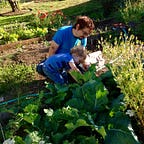“Decoding” Wild Ingredients
Wild Foods Challenge, Day 16
For the month of June, I’ll be taking the Wild Foods Challenge and trying to incorporate more found and foraged edible ingredients in my diet. I hope you’ll follow along!
“I don’t think there are such things as bad ingredients that nature made, you know. Its just a matter of kind of taming it or decoding it. That’s what we’re doing, we’re decoding our soil, our region.”
Rene Redzepi, “The Mind of a Chef”
Restricting your palette of wild ingredients to the “usuals,” or to recipes in foraging books, can severely limit your options. If you really want to participate in your local biosystem through wild foods, there will come a point where the “cook like spinach” or “add to soups” may get a little boring.
Thing is, if you look far enough and are willing to experiment, there are so many flavors all around you that you might not realize are there until you’ve “decoded” them.
There are many plants around us that aren’t toxic, but are also considered “inedible.” Some of these are, in fact, not edible because they don’t taste good or are too tough or or or, but often it’s simply a matter of convention. Take, for example, cleavers, or bedstraw (Galium aparine). Most books on foraging will tell you that mature cleavers are inedible — perhaps good for tea, but too “sticky” and stringy to use in a dish.
It’s true, you wouldn’t want to eat a forkful of mature cleavers, but if you learn to decode them, you can develop different ways to prepare them that highlights their almost refreshing flavor and allows you to use them even at their most mature.
Since we’re so unfamiliar with wild foods, it’s easy to compare their flavors to what we already know. Lambsquarters “taste like spinach.” Dock “tastes like sorrel.” Many flavors we can discover in the wild, however, defy comparison once “decoded.” Just as nothing “tastes like radish” but radish, so nothing tastes like (for example) the immature fruit of big leaf maple (Acer macrophyllum).
These are the samaras, or seedpods, that eventually turn into brown helicopters and flutter to the ground. Maple blossoms are a well-known wild edible, but few people know that the samaras can also be coaxed into edibility and have an incomparable taste that’s well worth exploring.
Supposedly the hard seed inside can also be ground into flour in fall (a future experiment, for sure!).
In point of fact, maple leaves can also impart a flavor when used in cooking (though they’re too tough to eat when mature). The indigenous people of the Pacific Northwest used big leaf maple leaves to wrap salmon for steaming, in the same way many cultures use banana leaves.
Finishing salts are a fantastic way to unlock interesting flavors in wild ingredients:
The salal flower salt, in particular, is strikingly delicious; it imparts a floral aftertaste to anything it’s sprinkled over.
I don’t have a great name for the recipe that follows, but experimentation helped me ‘decode’ the wild ingredients I discussed above. It’s quick and simple, and massively delicious.
Decoded Maple Packets with Cleaver Pesto Pork
Ingredients:
For the pesto:
- Approximately 1.5 cups mature cleavers, blanched:
- 2 cloves garlic
- 1/4 cup pine nuts or sunflower seeds
- 1/2 cup grated Parmesan cheese
- 1 tbsp salal salt
- approx. 3/4 cup olive oil
For the packets:
- 1 lb ground pork
- 8 enormous big leaf maple leaves
- a handful of big leaf maple samaras
- Cover the maple leaves in water and leave to soak for at least an hour. You could use some other liquid, but I wanted the flavor to come out.
- Chop the cleavers coarsely and add to a food processor with the garlic, Parmesan cheese, nuts/seeds, and salt. Pulse, gradually adding the olive oil until the consistency is smooth.
3. Mix the pesto into the pork.
4. After the leaves are done soaking, layer two of them in greased aluminum foil. Add about 1/4 of the pork mixture and top with maple fruit:
5. Fold the leaves over and wrap in the foil. Cook at 350F for approximately 45 minutes, or until internal temperature is 140F (I did these on a grill over indirect heat).
6. Remove, unwrap, and enjoy!
It’s fantastic as-is, but would also be lovely on a sandwich or served with some kind of sauce.
Want more WILD recipes? Follow along with the Wild Food Challenge on Invironment, and don’t forget to share with your pals/click the lil’ heart!
